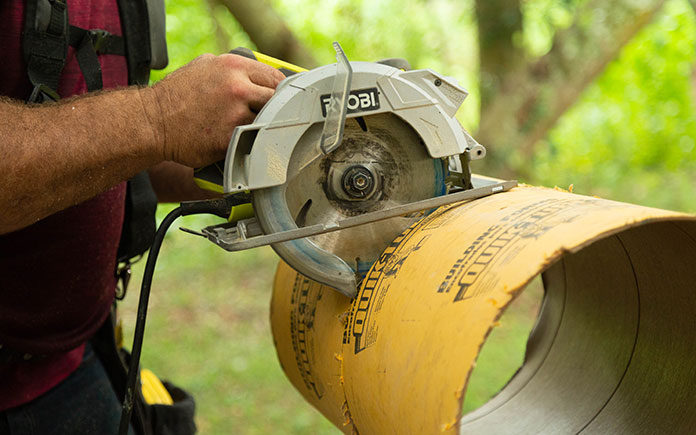Building a deck starts with setting a firm foundation — the concrete footings. And these must support the weight of deck materials and people.
This project takes time, and nothing should be left to chance. Fortunately, one tool makes it easier: QUIK-TUBE.
This ridged-fiber building form removes the need to build wooden forms. Just dig the holes for footings, cut the forms to size with a saw, and place them in the holes. Work smarter, not harder!
Materials
- Quikrete Quik-Tubes
- Quikrete 5000, High Early Strength Concrete Mix
- Chemical-resistant gloves
- Measuring tape
- Post hole digger
- Trowel
- J bolt
- Circular saw
- Safety glasses

Important: Before you start this project, check local building codes. You need to understand local construction requirements such as the deck footings’ smallest allowable diameter and smallest allowable depth.
Freeze-thaw cycles can affect the foundation, so footings typically must extend below the frost line.
Stay safe: Always wear pants, a long-sleeve shirt, safety glasses and chemical-resistant gloves when working with concrete mix.
How to Build Deck Footings
Follow these steps to build strong deck footings.
1. Lay out the deck foundation’s location.
Make sure it’s square and level with the house. It also must be the proper height so the deck boards line up with the home’s interior floor.
2. Mark the location of each deck post’s footing. Then dig 2-by-2-foot holes that are 2 feet deep.

3. Insert a Quikrete Quik-Tube in each hole.
4. Refer to the ‘At A Glace’ calculator on the Quik-Tube to determine the number of bags you would need per form or use Quikrete’s Concrete Calculator.
5. Mix up the bag of Quikrete 5000, High Early Strength Concrete Mix, as directed.
6. Pour the concrete into the Quik-Tube forms and smooth it off at the top.


7. As the concrete begins to stiffen, insert a “J bolt” attached to a galvanized metal post saddle.
8. When the concrete is dry, tighten the nut on the J bolt and install the deck post.
Watch the video above to learn more.
Further Information
- How to Install Deck Boards (video)
- How to Choose Between Composite and Wood Decking (video)
- How to Build Deck Stairs (video)
- How to Build Deck Handrails (video)










